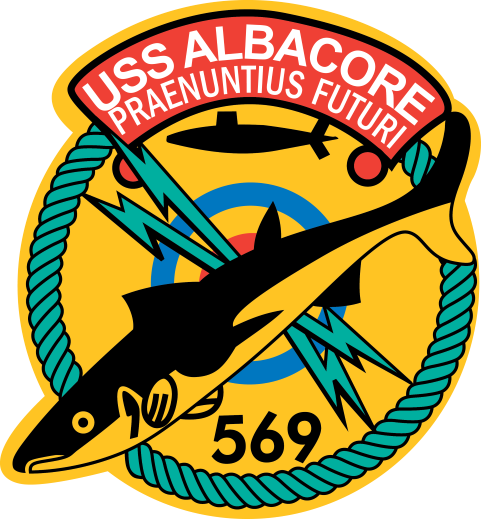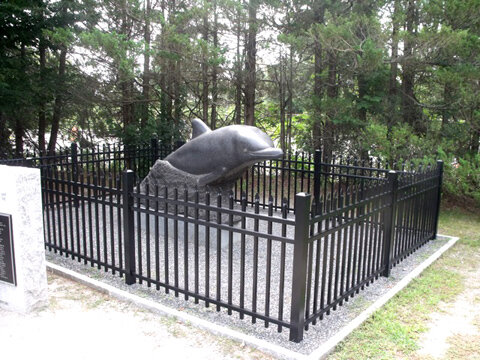Memorial Garden
The Memorial Garden preserves the memory of those who have served on Albacore and other U.S. submarines. We invite visitors to come and spend some time in quiet reflection. The Memorial Garden can be visited free of charge.
Location within the Park
Just to the right of the main entrance of the Visitor's Center is the Memorial Garden, an area set aside for reflection and remembrance. Within the garden are several granite monuments commemorating submarines lost during World War II and the Cold War.
Also within the garden is a carving of a dolphin made from black Canadian granite, the dolphin being the symbol of the submarine service. Several granite benches allow visitors to sit and contemplate the sacrifices made by those who choose to support and defend their country as a member of the Silent Service.
Origin of the Submarine Dolphin Insignia
Dolphins, the insignia of the US Navy Submarine Service, identify the wearer as "Qualified in Submarines." Becoming "Qualified" entails undergoing a rigorous program of learning all the systems within a submarine and demonstrating a practical knowledge of these systems. The process may take up to six months for enlisted men and a year for officers.
The origin of the dolphin insignia dates back to June of 1923 when then Captain Ernest J. King, who was Commander of Submarine Division Three, suggested to the Secretary of the Navy that a distinguishing device for qualified submariners be adopted. Captain King was later named a Fleet Admiral and was the Chief of Naval Operations during WWII.
The insignia adopted in March of 1924 is a bow view of a submarine running on the surface with its bow planes rigged out for diving and is flanked by dolphins with their heads resting on the edge of the planes. Dolphins are symbolic of a calm sea and are the traditional attendants of Poseidon, the Greek God of the Sea.
Garden Monuments
Five of the monuments in the Garden commemorate the loss of a specific submarine.
The O-9 (SS-70) was lost on June 20, 1941 with all hands. A World War I submarine, the O-9 was reactivated before the start of WWII and was being used for crew training when it went down off the Isle of Shoals. The boat is believed to rest in 432 feet of water ten miles southeast of Kittery, Maine.
The Squalus (SS-192) was lost off the New Hampshire coast on May 23, 1939 during new construction sea trials. Twenty-two officers and men and two civilians were lost when the main induction air valve failed to properly shut on a test dive. Thirty-three survivors were rescued through the use of the McCann Rescue Chamber. This was the first time that submariners had been retrieved from a sunken submarine. The Squalus was later raised and reconditioned at the Portsmouth Naval Shipyard. The boat was renamed Sailfish and recommissioned on May 15, 1940. She served in the Pacific during WWII and was decommissioned in October of 1945. Her sail is a monument at the Portsmouth Naval Shipyard.
During the Cold War period, two US submarines were lost. The third monument in the garden is dedicated to the USS Thresher (SSN-593) which was lost during sea trials on April 10, 1963. The boat was lost with 129 military and civilian personnel off the New England continental shelf during a deep dive. (The second submarine loss during the Cold War was the USS Scorpion (SSN-589). Scorpion was lost south of the Azores returning home from an overseas deployment in May of 1968).
Another monument in the Garden honors the USS Capelin (SS-289) lost during her second patrol during World War II. Capelin was built at the nearby Portsmouth Naval Shipyard. The New Hampshire chapter of the Submarine Veterans of WWII provided and dedicated this monument on Memorial Day of 2006.
The fifth monument is dedicated to the officers and men lost on the 52 submarines that failed to return from patrols during World War II. Included in that group is the first submarine Albacore (SS-218). A total of 374 officers and 3,131 enlisted men lie in the world's oceans still on their "Final Patrol." US submariners, making up 2 percent of the Navy during WWII, accounted for 55 percent of Japan's maritime losses. Of the 288 US submarines that participated in WWII, a little over one in five failed to survive the war. This monument recognizes the successful role they played in the war in the Pacific and honors their sacrifices.
Taken from just outside the entrance to the Memorial Garden, this picture shows the location of the monument dedicated to the USS Albacore (SS 218) lost with all hands on November 7, 1944. The other monuments are off to the right of the two benches seen in the right background.
A close-up of the newly placed monument to the first submarine Albacore.
Located at the southern end of the Memorial Garden is a new monument that was set in place in June of 2015. This monument honors the efforts of the artisans of the Portsmouth Naval Shipyard in building and maintaining some of the finest submarines in the world, the sailors who man these outstanding submarines, and the many volunteers whose contributions of time and talent make Albacore Park an outstanding destination for visitors.












